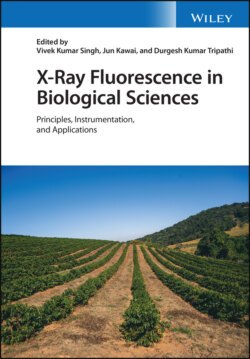Читать книгу X-Ray Fluorescence in Biological Sciences - Группа авторов - Страница 55
4.1 Introduction
ОглавлениеDetermination of different elements in ultra‐trace and trace amounts in biological systems is of great importance. These elements may be essential, which are required in certain amounts for smooth biological functioning or may be non‐essential and responsible for certain types of diseases if present in body. The essential elements may be a part of some enzymes and affect the chemical interactions in biological systems [1]. Some elements such as cadmium (Cd), nickel (Ni), arsenic (As), beryllium (Be), and chromium (Cr) are carcinogenic and have toxic effects on human and animal health, whereas accumulation of some elements in trace amounts such as zinc (Zn), strontium (Sr), and lead (Pb) in cartilages affects the progression of arthritis [2–3]. Several types of minerals and trace essential elements such as Zn, Fe, Cu, etc. also act as catalytic or structural components of large biochemical molecules and are thus essential trace elements, whereas some metallic elements are used in dental and medical materials and devices [4]. In addition, some toxic elements get introduced into the biological system from contaminated food, polluted air or water and cause harmful effects to human beings or animals. Determinations of such elements are very important to correlate them with the observed biological diseases or effects. Some of the elements, present in drinking water, vegetables, and food products, are essential for human and animals, whereas some may be toxic to biological systems if taken in more than the specified quantities. The extent of toxicity and dietary requirement of these elements, for inherent dangers and good progression of human life, determines the specifications of the elements in various biological systems. In view of the role played by these elements in biological processes, the determination of concentration of these elements in above materials is very important. The classical methods used for such determinations are mostly destructive and damage the cell tissue samples. Moreover, they require a comparatively large amount of sample and are thus not well suited for analysis of biological samples which are normally available only in very small quantities. This is because getting large amount of such samples, even in mg levels, is difficult in most cases and destruction of the sample inhibits the study of distribution of trace elements and other properties in the biological cells. Moreover, the samples once used, especially in inductively coupled plasma with optical emission spectroscopy (ICP‐OES) and inductively coupled plasma mass spectrometric (ICP‐MS) analysis, are completely consumed and not available for analysis again, if required, for re‐checking in case of any doubt in the results. Therefore, a rapid and non‐destructive/non‐consumptive method of elemental analysis of biological samples is required. X‐ray fluorescence (XRF) analysis provides useful elemental information about specimens without causing specimen damage with simple sample preparations. The determination of the required elements in biological systems can be done in a non‐destructive manner using XRF [5, 6].
